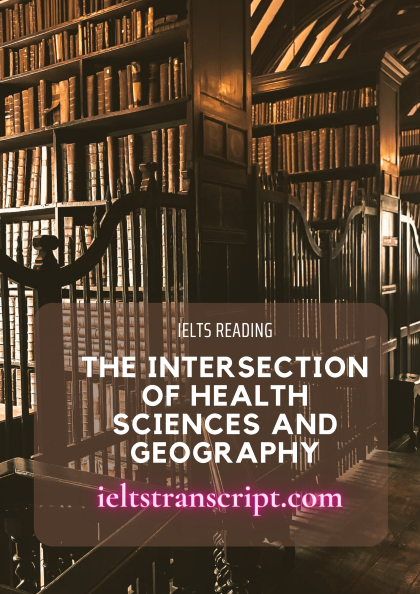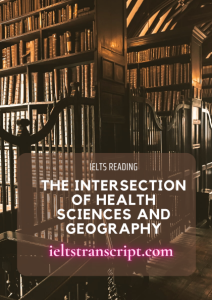- Đối với sản phẩm có giá: Sau khi chúng tôi ghi nhận thông tin đã thanh toán sản phẩm của bạn, sản phẩm sẽ được mở khóa và bạn có thể xem trực tiếp và tải tài liệu sản phẩm.
- Đối với thành viên trả phí: Bạn có thể mua và thanh toán sản phẩm với giá 0đ để tải tài liệu sản phẩm.
- Bạn có thể liên hệ với chúng tôi để được hỗ trợ mở khóa sản phẩm sớm nhất.
THE INTERSECTION OF HEALTH SCIENCES AND GEOGRAPHY
- Chúng tôi chấp nhận các phương thức thanh toán sau đây: Thẻ tín dụng, thẻ ghi nợ, PayPal, chuyển khoản ngân hàng và tiền mặt.
Chúng tôi sẽ không thu thêm phí cho bất kỳ hình thức thanh toán nào.
- Nếu bạn gặp vấn đề về sản phẩm của chúng tôi trong thời gian sử dụng, vui lòng liên hệ với chúng tôi để được hỗ trợ xử lý sớm nhất nhé.
Xem trước mẫu
The Intersection of Health Sciences and Geography
A While many diseases that affect humans have been eradicated due to improvements in vaccinations and the availability of healthcare, there are still areas around the world where certain health issues are more prevalent. In a world that is far more globalised than ever before, people come into contact with one another through travel and living closer and closer to each other. As a result, super-viruses and other infections resistant to antibiotics are becoming more and more common.
B Geography can often play a very large role in the health concerns of certain populations. For instance, depending on where you live, you will not have the same health concerns as someone who lives in a different geographical region. Perhaps one of the most obvious examples of this idea is malaria-prone areas, which are usually tropical regions that foster a warm and damp environment in which the mosquitos that can give people this disease can grew. Malaria is much less of a problem in high-altitude deserts, for instance.
C In some countries, geographical factors influence the health and well-being of the population in very obvious ways. In many large cities, the wind is not strong enough to clear the air of the massive amounts of smog and pollution that cause asthma, lung problems, eyesight issues and more in the people who live there. Part of the problem is, of course, the massive number of cars being driven, in addition to factories that run on coal power. The rapid industrialisation of some countries in recent years has also led to the cutting down of forests to allow for the expansion of big cities, which makes it even harder to fight the pollution with the fresh air that is produced by plants.
D It is in situations like these that the field of health geography comes into its own. It is an increasingly important area of study in a world where diseases like polio are re-emerging, respiratory diseases continue to spread, and malaria-prone areas are still fighting to find a better cure. Health geography is the combination of, on the one hand, knowledge regarding geography and methods used to analyse and interpret geographical information, and on the other, the study of health, diseases and healthcare practices around the world. The aim of this hybrid science is to create solutions for common geography-based health problems. While people will always be prone to illness, the study of how geography affects our health could lead to the eradication of certain illnesses, and the prevention of others in the future. By understanding why and how we get sick, we can change the way we treat illness and disease specific to certain geographical locations.
E The geography of disease and ill health analyses the frequency with which certain diseases appear in different parts of the world, and overlays the data with the geography of the region, to see if there could be a correlation between the two. Health geographers also study factors that could make certain individuals or a population more likely to be taken ill with a specific health concern or disease, as compared with the population of another area. Health geographers in this field are usually trained as healthcare workers, and have an understanding of basic epidemiology as it relates to the spread of diseases among the population.
F Researchers study the interactions between humans and their environment that could lead to illness (such as asthma in places with high levels of pollution) and work to create a clear way of categorising illnesses, diseases and epidemics into local and global scales. Health geographers can map the spread of illnesses and attempt to identify the reasons behind an increase or decrease in illnesses, as they work to find a way to halt the further spread or re-emergence of diseases in vulnerable populations.
G The second subcategory of health
...Giao điểm của Khoa học Sức khỏe và Địa lý
A. Mặc dù nhiều căn bệnh ảnh hưởng đến con người đã được loại trừ nhờ những cải tiến trong tiêm chủng và dịch vụ chăm sóc sức khỏe luôn sẵn sàng, vẫn còn những khu vực trên khắp thế giới mà một số vấn đề sức khỏe vẫn đang diễn ra phổ biến. Trong một thế giới đang toàn cầu hóa hơn bao giờ hết, mọi người tiếp xúc với nhau thông qua các chuyến đi và sinh sống ngày càng gần nhau hơn. Kết quả là, siêu vi-rút và các bệnh nhiễm trùng kháng thuốc kháng sinh khác ngày càng trở nên phổ biến hơn.
B.Địa lý thường có thể đóng một vai trò rất lớn trong các vấn đề về sức khỏe của một số nhóm dân cư nhất định. Ví dụ, tùy thuộc vào nơi bạn sống, bạn sẽ không có những lo lắng về sức khỏe giống như những người sống ở một khu vực địa lý khác. Có lẽ một trong những ví dụ rõ ràng nhất của quan điểm này là các khu vực dễ bị sốt rét, thường là các khu vực nhiệt đới nuôi dưỡng một môi trường ấm áp và ẩm ướt, nơi loài muỗi gây ra căn bệnh này cho người dân có thể phát triển. Sốt rét lại không phải là một vấn đề đáng lo ngại ở các nơi ví dụ như sa mạc cao.
C.Ở một số quốc gia, các yếu tố địa lý ảnh hưởng đến sức khỏe và hạnh phúc của người dân theo những cách rất rõ ràng. Ở nhiều thành phố lớn, gió không đủ mạnh để làm sạch không khí bởi lượng lớn khói bụi và ô nhiễm gây ra bệnh hen suyễn, các vấn đề về phổi, các vấn đề về thị lực và nhiều vấn đề khác ở những người sống ở đó. Tất nhiên, một phần của vấn đề là do số lượng lớn ô tô được sử dụng, bên cạnh các nhà máy chạy bằng năng lượng than. Quá trình công nghiệp hóa nhanh chóng của một số quốc gia trong những năm gần đây cũng dẫn đến chặt phá rừng để mở rộng các thành phố lớn, khiến việc chống ô nhiễm bầu không khí trong lành do thực vật tạo ra càng khó khăn hơn.
D.Trong những trường hợp như thế này, lĩnh vực địa lý y tế được phát huy. Đây là một lĩnh vực nghiên cứu ngày càng quan trọng trong một thế giới mà các bệnh như bại liệt đang tái phát, các bệnh về đường hô hấp tiếp tục lây lan và các khu vực dễ bị sốt rét vẫn đang chiến đấu để tìm ra phương pháp chữa trị tốt hơn. Địa lý y tế một mặt là sự kết hợp của kiến thức về địa lý và các phương pháp được sử dụng để phân tích và giải thích thông tin địa lý, mặt khác là nghiên cứu về sức khỏe, bệnh tật và thực hành chăm sóc sức khỏe trên khắp thế giới. Mục đích của lĩnh vực khoa học kết hợp này là tìm ra giải pháp cho các vấn đề sức khỏe phổ biến dựa trên địa lý. Mặc dù con người sẽ luôn dễ bị bệnh, nhưng nghiên cứu về cách địa lý ảnh hưởng đến sức khỏe của chúng ta có thể giúp loại bỏ một số bệnh tật và ngăn ngừa những bệnh trong tương lai. Bằng cách hiểu tại sao và làm thế nào chúng ta mắc bệnh, chúng ta có thể thay đổi cách điều trị bệnh tật cụ thể cho các vị trí địa lý nhất định.
E.Địa lý bệnh tật phân tích tần suất xuất hiện một số bệnh nhất định ở các khu vực khác nhau trên thế giới, và đối chiếu dữ liệu với địa lý của khu vực để xem liệu có thể có mối tương quan giữa hai tầng địa lý này hay không. Các nhà địa lý y tế cũng nghiên cứu các yếu tố có thể làm cho một số cá nhân hoặc một quần thể có nhiều khả năng bị ốm do một vấn đề sức khỏe hoặc bệnh tật nhất định, so với dân số của một khu vực khác. Các nhà địa lý y tế trong lĩnh vực này thường được đào tạo thành nhân viên y tế và có hiểu biết về dịch tễ học cơ bản vì nó liên quan đến sự lây lan của các dịch bệnh trong dân số.
F.Các nhà nghiên cứu tìm hiểu sự tương tác giữa con người và môi trường có thể dẫn đến bệnh tật của họ (chẳng hạn như bệnh hen suyễn ở những nơi có mức độ ô nhiễm cao) và nghiên cứu để tạo ra một cách phân loại bệnh tật và dịch bệnh rõ ràng theo quy mô địa phương và toàn cầu. Các nhà địa lý y tế có thể lập bản đồ lây lan của bệnh tật và cố gắng xác định các lý do đằng sau sự gia tăng hoặc sụt giảm lượng bệnh tật để cố gắng tìm cách ngăn chặn lây lan hoặc tái phát ở các nhóm dân số dễ bị ảnh hưởng.
G.Kiểu thứ hai của địa lý y tế là lĩnh vực địa lý cung cấp dịch vụ chăm sóc sức khỏe. Nhóm này nghiên cứu tính sẵn có (hoặc thiếu thốn)
...Để xem được đầy đủ nội dung và tải dữ liệu, bạn phải trở thành thành viên của chúng tôi và trả phí cho tài liệu (nếu có)











